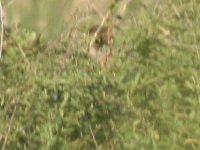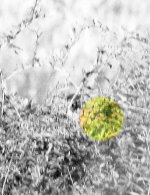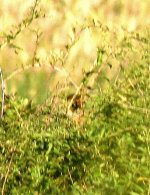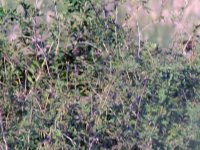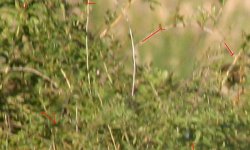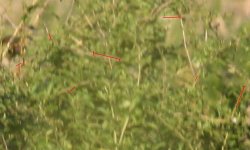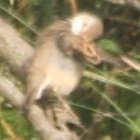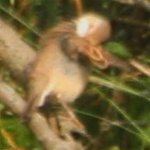This is a remarkable story about a (1) or several birds I have never seen before!
To summarise this:
Location The Netherlands (Holland), North Western Europe, there is a reason for that last extra location indication.
Time of year: Summer 2013, multiple sightings, in year 2014 only one(1) flying bird, could not find it again.
Weatherconditions
Year: 2013, an icy long lasting cold spring, but in late April and May south eastern winds lasting for weeks.
Year 2014 a very balmy winter and high temperatures in March and April but bad rain ridden weather in the first weeks of May 2014
South West winds from the Atlantic and a few days NW-winds from Artic
I am a pretty much experienced birder since age of 7.
Not ment to be as an introduction or to boast or anything, just that you know.
I am mid-aged now, my first years I did birding actually without any binoculars at all (poverty builds character they say, I dunno about that but this handicap actually became a strength which certainly helped( and still helps) me develop a keen eye for a quick determination without constantly grasping for the bino's.
I've been in the Mediterranean a lot ( North Europe's favorite Holyday destination), the Middle East, Africa,North Amerca, North Eastern Europe and Russia.
I cannot compare the bird(s) in question with any of my own experiences nor any Bird Field guide or research on the net.
My first impression was Woodchat Shrike or as we call it in Holland;
Redcrested Shrike :Lanius senator, a former rare breeder, now a regular but still rare migrator/ visitor especially with southtern winds in spring they overshoot their breeding grounds in France and yhe ZSouth of Germany.
It has fairly the same pattern in plumage (at first glance) but his behaviour is totally different, shy, elusive, secretive and having a very social life (I never saw one single bird with exception of 2014),and it sometimes perches always half a mile away , of course and most of the time it and or they move(s) through thickets, bushes and more to ground level in long grass or weeds.
They are very hard to spot and it is even harder to make a photograph.
Size varies from 6 to 8 inches, in metric from 15 to 18 centimeter.
Plumage is basically:
Male (?)
Fire-engine red or brownish red crest depending on light conditions or age of the bird?
black topside or upper parts of wings with white vertical bar on each wing,( shoulderpatch) light or white coloured on chin, breast and belly, some individuals were lichtly barred on the underparts.
The moustache or beard contrasting whith the wite cheek
Tail a bit wedge shapedl just like indeed a Shrike.
Female (?)
Cinnamon brown is a typical Dutch word but reddish brown like a reed warbler will do and in the facial area a dark or blackish stripe or eye mark, blackish masked eye
To make it less complicated I also saw all kinds of colourfull or streaked patterns.
This cvould implicate an escaped exotic birdspecies gone astray or wild and being quite succesfull since I spotted multiple animals on various locations.
Sound: with the exception of alarm calls from the reed wearbler reddish brown females ( again very similar with Shrikes !) I could not hear anything.
My educated guess is that since they are very social in groups and their behaviour, there is no need for territorial disputes and therefore singing.
Any hgigh pitched squeaks and or noises could be done by any other kindf of bird in the area.
Of course I checked every possible bird \or birdfamily well known and widespread in the area with any similarities like for instance spotted woodpecker, but they did not compare or check out.
Any other bird like Woodchat Shrike or Red backed Sjrike* allthough with some striking similarities and resemblance did not check out.
Red backed Shrike is a irregular but not uncommon seasonal passenger/ visitor in Western part of the Netherlands, in eastern parts a locally wide spread breeding species.
Used to breed in the western parst of dfunal and coastal area;s and is coming back slowly after special conservational planning and restoration of certain area's,
Any bird with even a remote chance of similarity or resemblance has been researched by me in a dozen fieldguides spanning three continents, they did not check out.
Internet search on a variety of bird determination sites including this one did not check out.
Checking for exotic birds being held in (il)leghal captivity did not check out.
Breeding and or youngsters, I probally have one photo ( again) with a relativly good picture of a young bird, notice the white cheek -area, the stripe running horizontal through the eye and accros the head, ehile the head/ crest itself is a reddish brown hood/ cap.
Username 8ub is a kind of sarcastic intended pun, because I christened the bird; Bub
Big Unknown Bird and it took me almost 8 weeks after the first sighting end of May till I got the first picture ( basically the one shown)
Year 2013
I have managed after weeks and weeks of stake outs and early rises to make one (1) acceptable photgraph only.
It is part of a serie of multiple shots and one can see like in a storyboard for a cartoon how it quickly goes up out of the bush and down again, 'pop' says the weasel indeed.
Year 2014
Basically nothing, one sighting of a flying bird, flying by the way is also very much like Shrike style, short rushes pretty much close and low to the ground or surface, never seen one flying higher than 20 meters or 70 feet.
Flying is something they tend to avoid or do with reluctance, they are waiting it out till the very end so giving you either a heart attack or makes it quite unpredictable to try to make a photograph
( settings camera & lense)or to persuade it to fly to a certain area or bush/ tree so you have a better chance to make a picture.
They prefer to hide in thick busdhes like f.i blackberry, the bigger the better or any given thicket/ brush in ther surrounding and or make an running escape through the vine so to speak.
Flying is the ultimate escape plan.
Wings pretty much the same as ; Thrushes or again Shrikes with the very in your face black and white pattern
Any help is very much appreciated
My skills according to photoshopping are quite low, but if one would view the crops attached with this appeal should be in for some surprises.
Thank you
[email protected]
To summarise this:
Location The Netherlands (Holland), North Western Europe, there is a reason for that last extra location indication.
Time of year: Summer 2013, multiple sightings, in year 2014 only one(1) flying bird, could not find it again.
Weatherconditions
Year: 2013, an icy long lasting cold spring, but in late April and May south eastern winds lasting for weeks.
Year 2014 a very balmy winter and high temperatures in March and April but bad rain ridden weather in the first weeks of May 2014
South West winds from the Atlantic and a few days NW-winds from Artic
I am a pretty much experienced birder since age of 7.
Not ment to be as an introduction or to boast or anything, just that you know.
I am mid-aged now, my first years I did birding actually without any binoculars at all (poverty builds character they say, I dunno about that but this handicap actually became a strength which certainly helped( and still helps) me develop a keen eye for a quick determination without constantly grasping for the bino's.
I've been in the Mediterranean a lot ( North Europe's favorite Holyday destination), the Middle East, Africa,North Amerca, North Eastern Europe and Russia.
I cannot compare the bird(s) in question with any of my own experiences nor any Bird Field guide or research on the net.
My first impression was Woodchat Shrike or as we call it in Holland;
Redcrested Shrike :Lanius senator, a former rare breeder, now a regular but still rare migrator/ visitor especially with southtern winds in spring they overshoot their breeding grounds in France and yhe ZSouth of Germany.
It has fairly the same pattern in plumage (at first glance) but his behaviour is totally different, shy, elusive, secretive and having a very social life (I never saw one single bird with exception of 2014),and it sometimes perches always half a mile away , of course and most of the time it and or they move(s) through thickets, bushes and more to ground level in long grass or weeds.
They are very hard to spot and it is even harder to make a photograph.
Size varies from 6 to 8 inches, in metric from 15 to 18 centimeter.
Plumage is basically:
Male (?)
Fire-engine red or brownish red crest depending on light conditions or age of the bird?
black topside or upper parts of wings with white vertical bar on each wing,( shoulderpatch) light or white coloured on chin, breast and belly, some individuals were lichtly barred on the underparts.
The moustache or beard contrasting whith the wite cheek
Tail a bit wedge shapedl just like indeed a Shrike.
Female (?)
Cinnamon brown is a typical Dutch word but reddish brown like a reed warbler will do and in the facial area a dark or blackish stripe or eye mark, blackish masked eye
To make it less complicated I also saw all kinds of colourfull or streaked patterns.
This cvould implicate an escaped exotic birdspecies gone astray or wild and being quite succesfull since I spotted multiple animals on various locations.
Sound: with the exception of alarm calls from the reed wearbler reddish brown females ( again very similar with Shrikes !) I could not hear anything.
My educated guess is that since they are very social in groups and their behaviour, there is no need for territorial disputes and therefore singing.
Any hgigh pitched squeaks and or noises could be done by any other kindf of bird in the area.
Of course I checked every possible bird \or birdfamily well known and widespread in the area with any similarities like for instance spotted woodpecker, but they did not compare or check out.
Any other bird like Woodchat Shrike or Red backed Sjrike* allthough with some striking similarities and resemblance did not check out.
Red backed Shrike is a irregular but not uncommon seasonal passenger/ visitor in Western part of the Netherlands, in eastern parts a locally wide spread breeding species.
Used to breed in the western parst of dfunal and coastal area;s and is coming back slowly after special conservational planning and restoration of certain area's,
Any bird with even a remote chance of similarity or resemblance has been researched by me in a dozen fieldguides spanning three continents, they did not check out.
Internet search on a variety of bird determination sites including this one did not check out.
Checking for exotic birds being held in (il)leghal captivity did not check out.
Breeding and or youngsters, I probally have one photo ( again) with a relativly good picture of a young bird, notice the white cheek -area, the stripe running horizontal through the eye and accros the head, ehile the head/ crest itself is a reddish brown hood/ cap.
Username 8ub is a kind of sarcastic intended pun, because I christened the bird; Bub
Big Unknown Bird and it took me almost 8 weeks after the first sighting end of May till I got the first picture ( basically the one shown)
Year 2013
I have managed after weeks and weeks of stake outs and early rises to make one (1) acceptable photgraph only.
It is part of a serie of multiple shots and one can see like in a storyboard for a cartoon how it quickly goes up out of the bush and down again, 'pop' says the weasel indeed.
Year 2014
Basically nothing, one sighting of a flying bird, flying by the way is also very much like Shrike style, short rushes pretty much close and low to the ground or surface, never seen one flying higher than 20 meters or 70 feet.
Flying is something they tend to avoid or do with reluctance, they are waiting it out till the very end so giving you either a heart attack or makes it quite unpredictable to try to make a photograph
( settings camera & lense)or to persuade it to fly to a certain area or bush/ tree so you have a better chance to make a picture.
They prefer to hide in thick busdhes like f.i blackberry, the bigger the better or any given thicket/ brush in ther surrounding and or make an running escape through the vine so to speak.
Flying is the ultimate escape plan.
Wings pretty much the same as ; Thrushes or again Shrikes with the very in your face black and white pattern
Any help is very much appreciated
My skills according to photoshopping are quite low, but if one would view the crops attached with this appeal should be in for some surprises.
Thank you
[email protected]
Attachments
Last edited:




